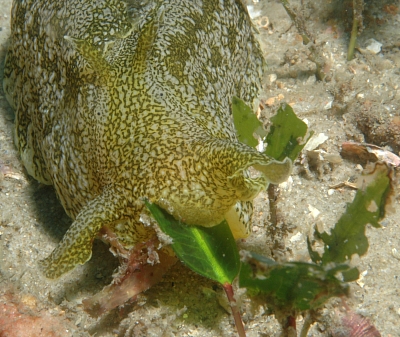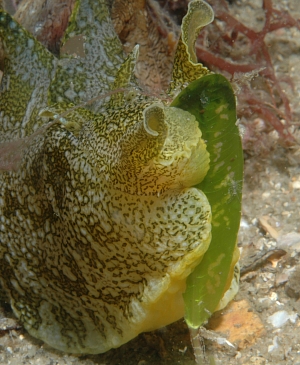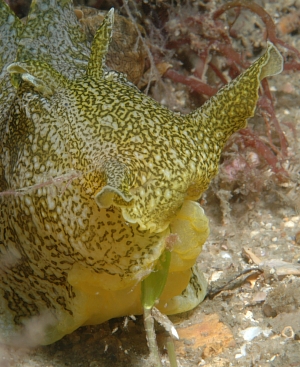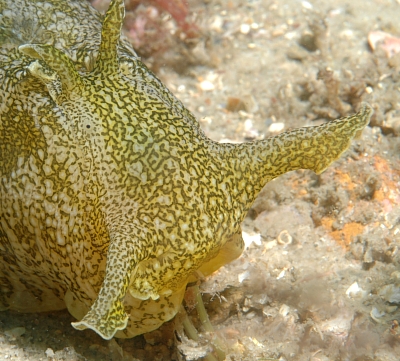Syphonata geographica feeding on Halophila
November 27, 2007
From: Leanne & David Atkinson

Hi Bill,
We've been finding a few Syphonota geographica in the same area as the Petalifera ramosa and some Aplysia sydneyensis so we have been watching closely to try to see what they eat and hoping to catch them laying eggs or mating. We found this Syphonata geographica grazing on the leaf shaped seaweed that we've been finding the Petalifera ramosa on. The Petaliferas seem to glide over as if they are grazing on something on the surface since there are no sign of damage. This Syphonata geographica just munches its way through the entire leaf. Here is an action sequence. Hope it is of interest. We haven't seen the burrowing under the sand as mentioned in other postings but there does seem to be a root system under the sand maybe they can camouflage and eat at the same time.
Locality: Fly Point, Marine Park, Port Stephens, 8 metres, New South Wales, Australia, Pacific, 10 November 2007, Sandy bottom scattered sponges, ascidians and seaweed. Length: approximately 130 mm. Photographer: Leanne & David Atkinson.
Hope this finds you well.
Regards,
Leanne & David Atkinson
atk@hunterlink.net.au



Dear Leanne & David,
This is a very interesting observation as I know of no direct observations of Syphonota feeding. The plant they are eating in your photos is a flowering plant rather than an algae. It is the sea grass Halophila, probably Halophila ovata, but I am no expert on sea grasses. There is an earlier message from Singapore [#9109] showing a Syphonota burrowing right by a clump of same sea grass which may be more than a coincidence.
Even more interesting is scientifc paper published earlier this year (Gavagnin et al, 2007) which reports on the secondary metabolites found in Syphonota, including one molecule that suggested that Syphonota geographica feeds on the sea grass Halophila stipulacea. As I said to Margherita Gavagnin at the time [message #20811] this type of research is proving to be a powerful tool in linking particular species to their food items.
Your observation certainly confirms this.
- M. Gavagnin, M. Carbone, P. Amodeo, E. Mollo, R. M. Vitale, V. Roussis and G. Cimino. (2007) Structure and absolute stereochemistry of syphonoside: a unique macrocyclic glycoterpenoid from marine organisms. J. Org. Chem., 72: 5625-5630.
Best wishes,
Bill Rudman
Related messages
-
Seahare from Lembeh, Indonesia
From: Zeineb Alhaidari, November 9, 2009 -
Syphonota geographica from South Africa
From: Valda Fraser, June 2, 2008 -
Syphonata geographica eggs
From: Leanne & David Atkinson, February 25, 2008 -
Syphonata geographica mating
From: Leanne & David Atkinson, February 25, 2008 -
Re: Seahare from Singapore
From: Ron Yeo, March 29, 2007 -
Syphonota geographica from Bali
From: Teresa (Zubi) Zuberbühler, February 19, 2007 -
Syphonota geographica from northern Bali
From: Danny van Belle, January 31, 2007 -
Syphonota geographica from Dominica
From: Linda Ianniello, July 23, 2004 -
Syphonota geographica from Changi, Singapore
From: Ria Tan, February 5, 2003 -
Re: Syphonota geographica from Italy
From: Erwin Koehler, December 18, 2002 -
Re: Syphonota geographica from Turkey
From: Erwin Koehler, December 13, 2002 -
Syphonota geographica from Turkey
From: Ferda Buyukbaykal , December 12, 2002 -
Syphonota from Sydney
From: Akos Lumnitzer, June 1, 2000 -
Is Syphonota found in Australia or NZ?
From: P.M. Johnson, May 26, 1999
